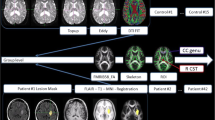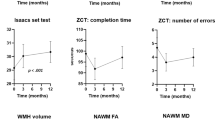Abstract
Purpose
To investigate proliferative reorganization in the bilateral corticospinal tract (CST) and functional reorganization in the sensorimotor network (SMN) after internal capsule stroke, and to examine the significance of this reorganization.
Methods
We recruited 17 patients with first-onset acute stroke (16 male, 1 female, mean age 52 ± 10 years) and 17 age- and sex-matched healthy controls. We excluded patients aged < 18 or > 65 years and those with lesions outside the unilateral internal capsule. All subjects underwent diffusion tensor imaging and resting-state functional MRI on days 7, 30, and 90 from symptom onset. We measured fractional anisotropy (FA) in the CST, interhemispheric functional connectivity (FC) within the SMN, and pre-MRI clinical scores, including the National Institutes of Health Stroke Scale (NIHSS), Barthel Index (BI), and Fugl–Meyer (FM). Correlations among the changes in FA, FC, and clinical scores were analyzed.
Results
From day 7 to 90 after stroke, FA in the bilateral CST increased (ipsilesional side, Pinternal capsule = 0.009, Pcentrum semiovale = 0.001; contralesional side, Pinternal capsule = 0.006, Pcentrum semiovale = 0.017), as did FC (P < 0.05); NIHSS scores decreased (P < 0.05), while FM and BI progressively increased (P < 0.05). Increased FA in bilateral CST was negatively correlated with decreased NIHSS scores. Increased FA in only the ipsilesional side was positively correlated with increased FM. Increased FC was positively correlated only with increased BI.
Conclusion
Proliferative reorganization in the CST and functional reorganization in the SMN support and promote neurological functional recovery after internal capsule infarction.




Similar content being viewed by others
References
Hara Y (2015) Brain plasticity and rehabilitation in stroke patients. J Nippon Med Sch 82(1):4–13
Ding G, Jiang Q, Li L, Zhang L et al (2008) Magnetic resonance imaging investigation of axonal remodeling and angiogenesis after embolic stroke in sildenafil treated rats. J Cereb Blood Flow Metab 28:1440–1448
Jiang Q, Zhang ZG, Ding GL et al (2006) MRI detects white matter reorganization after neural progenitor cell treatment of stroke. Neuroimage. 32:1080–1089
Jang SH, Byun WM, Han BS et al (2006) Recovery of a partially damaged corticospinal tract in a patient with intracerebral hemorrhage: a diffusion tensor image study. Restor Neurol Neurosci 24:25–29
Ma C, Liu A, Li Z et al (2014) Longitudinal study of diffusion tensor imaging properties of affected cortical spinal tracts in acute and chronic hemorrhagic stroke. J Clin Neurosci 21(8):1388–1392
George E, Heier L, Kovanlikaya I, Greenfield J (2014) Diffusion tensor imaging of pyramidal tract reorganization after pediatric stroke. Childs Nerv Syst 30(6):1135–1139
Kwak SY, Yeo SS, Choi BY et al (2010) Corticospinal tract change in the unaffected hemisphere at the early stage of intracerebral hemorrhage: a diffusion tensor tractography study. Eur Neurol 63:149–153
Schaechter JD, Fricker ZP et al (2009) Microstructural status of ipsilesional and contralesional corticospinal tract correlates with motor skill in chronic stroke patients. Hum Brain Mapp 30(11):3461–3474
Lin LY, Ramsey L, Metcalf NV et al (2018) Stronger prediction of motor recovery and outcome poststroke by corticospinal tract integrity than functional connectivity. PLoS One 13(8):e0202504
Friston KJ (1994) Functional and effective connectivity in neuroimaging: a synthesis. Hum Brain Mapp 2:56–78
De Bruyn N, Meyer S, Kessner SS et al (2018) Functional network connectivity is altered in patients with upper limb somatosensory impairments in the acute phase post stroke: a cross-sectional study. PLoS One 13(10):e0205693
Lee J, Park E, Lee A et al (2018) Alteration and role of interhemispheric and intrahemispheric connectivity in motor network after stroke. Brain Topogr 31(4):708–719
Chi NF, Ku HL, Chen DY et al (2018) Cerebral motor functional connectivity at the acute stage: an outcome predictor of ischemic stroke. Sci Rep 8(1):16803
Hernandez-Castillo CR, Nashed JY, Fernandez-Ruiz J et al (2017) Increased functional connectivity after stroke correlates with behavioral scores in non-human primate model. Sci Rep 7(1):6701
Hakon J, Quattromani MJ, Sjölund C et al (2017) Multisensory stimulation improves functional recovery and resting-state functional connectivity in the mouse brain after stroke. Neuroimage Clin 17:717–730
Cha J, Kim ST, Jung WB et al (2016) Altered white matter integrity and functional connectivity of hyperacute-stage cerebral ischemia in a rat model. Magn Reson Imaging 34(8):1189–1198
Xu H, Qin W, Chen H, Jiang L, Li K et al (2014) Contribution of the resting-state functional connectivity of the contralesional primary sensorimotor cortex to motor recovery after subcortical stroke. PLoS One 9(1):e84729
Golestani AM, Tymchuk S, Demchuk A et al (2013) Longitudinal evaluation of resting-state fMRI after acute stroke with hemiparesis. Neurorehabil Neural Repair 27(2):153–163
Zhang Y, Liu H, Wang L et al (2016) Relationship between functional connectivity and motor function assessment in stroke patients with hemiplegia: a resting-state functional MRI study. Neuroradiology 58:503–511
Lefebvre S, Dricot L, Laloux P et al (2017) Increased functional connectivity one week after motor learning and tDCS in stroke patients. Neuroscience. 340:424–435
Li Y, Wang Y, Liao C et al (2017) Longitudinal brain functional connectivity changes of the cortical motor-related network in subcortical stroke patients with acupuncture treatment. Neural Plast 2017:5816263
Fan YT, Wu CY, Liu HL et al (2015) Neuroplastic changes in resting-state functional connectivity after stroke rehabilitation. Front Hum Neurosci 9:546
van Meer MP, Otte WM, van der Marel K et al (2012) Extent of bilateral neuronal network reorganization and functional recovery in relation to stroke severity. J Neurosci 32(13):4495–4507
Carter AR, Patel KR, Astafiev SV et al (2012) Upstream dysfunction of somatomotor functional connectivity after corticospinal damage in stroke. Neurorehabil Neural Repair 26(1):7–19
Chen JL, Schlaug G (2013) Resting state interhemispheric motor connectivity and white matter integrity correlate with motor impairment in chronic stroke. Front Neurol 4:178
Liu J, Qin W, Zhang J, Zhang X, Yu C (2015) Enhanced interhemispheric functional connectivity compensates for anatomical connection damages in subcortical stroke. Stroke. 46(4):1045–1051
He Q, Turel O, Bechara A (2018) Association of excessive social media use with abnormal white matter integrity of the corpuscallosum. Psychiatry Res Neuroimaging 278:42–47
Smith S (2002) Fast robust automated brain extraction. Hum Brain Mapp 17:143–155
Andersson JLR, Jenkinson M, Smith S (2007a) Non-linear optimisation. FMRIB technical report TR07JA1 from www.fmrib.ox.ac.uk/analysis/techrep
Andersson JLR, Jenkinson M, Smith S (2007b) Non-linear registration, aka Spatial normalisation. FMRIB technical report TR07JA2 from www.fmrib.ox.ac.uk/analysis/techrep
Smitha SM, Foxb PT, Millera KL et al (2009) Correspondence of the brain’s functional architecture during activation and rest. PNAS 31:13040–13045
Wang C, Qin W, Zhang J et al (2014) Altered functional organization within and between resting-state networks in chronic subcortical infarction. J Cereb Blood Flow Metab 34(4):597–605
Zhao Z, Wu J, Fan M et al (2018) Altered intra- and inter-network functional coupling of resting-state networks associated with motor dysfunction in stroke. Hum Brain Mapp 39(8):3388–3397
Zhang H, Zuo XN, Ma SY, Zang YF, Milham MP, Zhu CZ (2010) Subject order-independent group ICA (SOI-GICA) for functional MRI data analysis. Neuroimage 51:1414–1424
van der Zijden JP, van der Toorn A, van der Marel K, Dijkhuizen RM (2008) Longitudinal in vivo MRI of alterations in perilesional tissue after transient ischemic stroke in rats. Exp Neurol 212:207–212
Carrera E, Tononi G (2014) Diaschisis: past, present, future. Brain 137(Pt 9):2408–2422
Andrews RJ (1991) Transhemispheric diaschisis. A review and comment. Stroke 22(7):943–949
Lindau NT, Bänninger BJ, Gullo M (2014) Rewiring of the corticospinal tract in the adult rat after unilateral stroke and anti-Nogo-A therapy. Brain 137(Pt 3):739–756
Carter AR, Astafiev SV, Lang CE et al (2010) Resting interhemispheric functional magnetic resonance imaging connectivity predicts performance after stroke. Ann Neurol 67(3):365–375
Funding
This study was funded by the National Key R&D Program of China (No. 2017YFC1307500, 2018YFC1311300), the National Natural Science Foundation of China (NSFC No. 30860088 and 81260186) and the Guangxi Natural Science Foundation (GNFC No. 0832134, 0991149, 2015GXNSFAA139228 and 2016GXNSFAA380281).
Author information
Authors and Affiliations
Corresponding author
Ethics declarations
Conflict of interest
The authors declare that they have no conflict of interest.
Ethical approval
All procedures performed in studies involving human participants were in accordance with the ethical standards of the institutional and/or national research committee and with the 1964 Helsinki declaration and its later amendments.
Informed consent
Additional informed consent was obtained from all individual participants for whom identifying information is included in this article.
Additional information
Publisher’s note
Springer Nature remains neutral with regard to jurisdictional claims in published maps and institutional affiliations.
Rights and permissions
About this article
Cite this article
Lu, Q., Huang, G., Chen, L. et al. Structural and functional reorganization following unilateral internal capsule infarction contribute to neurological function recovery. Neuroradiology 61, 1181–1190 (2019). https://doi.org/10.1007/s00234-019-02278-x
Received:
Accepted:
Published:
Issue Date:
DOI: https://doi.org/10.1007/s00234-019-02278-x




